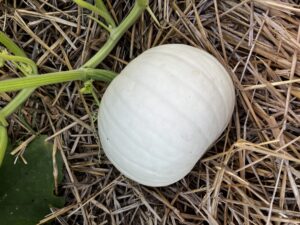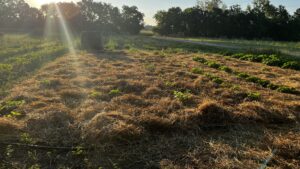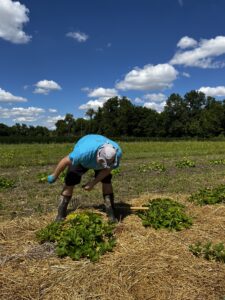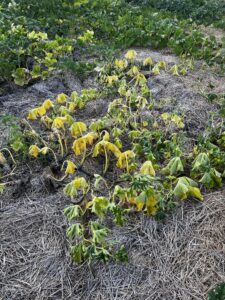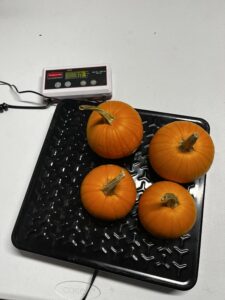Final report for FNC22-1342
Project Information
We have a 3.5 acre total operation for our pumpkin patch. We have attempted ornamental corn the previous two years with very limited results. In our first season we mulched our pumpkin crop with straw and in year two we did a rye cover crop. We believe in sustainable practices and have tried to adopt them as much as possible within our operation.
Time management, weed management, and soil management are all top priorities on our farm. This is now our third year as a pumpkin patch operation and weed management is our top concern. Every summer we spend 8 - 20 hours a week on weed control using garden/field hoes. This year, we grew the operation to 3 acres; unfortunately, we lost 30% of the crop to overgrown grasses and broadleaf plants. Weed pollen caused defects on the pumpkin skin that made them unmarketable. In my research I discovered evidence based weed management through a paper mulch that can be used to plant transplants or seeds in. Based on my research this will be the most economically viable option. I also plan to test using wheat straw as a mulch to suppress weeds and compare the results. Straw mulch is not as economically viable as the paper mulch but the improvements to the organic matter of the soils may out weigh the time required to spread the wheat straw. We will set the plot on drip irrigation as our July and August rains can be unpredictable. I expect paper mulch to be more economical than the straw for weed suppression.
- Identify which mulch is the most cost and time effective at weed suppression and water retention.
- Measure yield results between the different types of mulch for each type of pumpkin/squash.
- Baby Pam (pie)
- Snowball (white pie)
- Celebration (acorn squash)
- Crystal Star (large white)
- Phat Jack (large carving)
- Evaluate quality and marketability of pumpkin/squash between mulch types and cover.
- Rye cover crop with paper mulch
- Straw on top of rye cove crop
- Straw with paper mulch
- To share findings through Southwind Extension office, social media, and host a field day.
Research
We selected resources that were readily available from seed catalogs and other online resources or local box stores. We did not used anything that required a special license to use.
- Prepare for planting
- This involved mowing a strip in the cover crop to rototill for planting (strip till); each strip was six feet apart.
- Rototill the strip after mowing (16" tiller)- Note: after the first season of use we had to replace the engine with one that was heavy duty.
- Rolling out the drip tape over rows.
- Making hills for the pumpkins (Pie-size hills were spaced at 3' - 4' while extra large pumpkins were spaced 6' - 8 ' within the row.). These were 80' rows, and every 6' we had a row. Make squash/pumpkin mound every 2-3'.
- Planting
- Place 4 to 5 seeds per hill made in step four of preparing.
- Because of large amounts of rain in May the extra large pumpkins were planted in trays and transplanted to soil late.
- This years planting was delayed and we did not get the transplants and the seed in until late June. Typically, I prefer to have them planted before June 1st but weather and a planned vacation delayed planting until June 20th.
- We planted three types of squash/pumpkins: a smaller decorative pumpkin (snowball), a smaller size winter squash (celebration), and a larger jack-o-lantern pumpkin.
- Mulching: Paper and Straw, Hay, or Terminated Cover Crop
- Once plants were growing and had at least 4 true leaves the plants were mulched with one of the three mulching strategies: either:
- paper and straw,
- straw, or
- left with what the cover crop provided after termination.
- Once plants were growing and had at least 4 true leaves the plants were mulched with one of the three mulching strategies: either:
- Watering/Weeding/Pesticides
- One downside to the straw mulch is the squash bugs would hide in the straw and made them very difficult to manage.
- Once we sprayed both the leaves and the base our pest pressure dropped significantly
- Due to extreme drought the drip irrigation did not provide enough moisture to the cover-crop-only rows.
- The cover-crop-only rows proved to be difficult to kill weeds with the drip tape.
- We had hoped to purchase a drip layer but they were on back order in 2022.
- All rows were fertilized and watered equally through the drip tape.
- One downside to the straw mulch is the squash bugs would hide in the straw and made them very difficult to manage.
- Harvest
- We harvested by hand and compared the three treatments in terms of quality and yield. We did this for all three squash varieties.
What we saw was that the paper mulch was a key component: it kept weeds down more than the other treatments alone, retained more moisture, and made it easier to prep the squash for sale. A few more details:
- We saw an approximately 15% yield bump between paper and straw vs. only straw. And compared to no mulch at all (meaning, only the terminated cover crop), we saw a 2-3x yield bump overall.
- For the smaller decorative pumpkin (snowball) and smaller size winter squash (celebration): The covered rows were 3-5x more in yield than the terminated cover crop rows.
- For the larger pumpkin for jack-0-lantern: Given the drought year, this did not do well at all, in any treatment. That said, the paper mulched rows produced better than the non-cover rows.
- The quality as far as appearance and prep for sale was best on the paper row. About 20% required more cleaning on the rows with mulch but no paper. On the no-mulch, you have to clean 100% of squash/pumpkin.
- Bugs were also an issue in the no-cover row, and especially the weed suppression was a bigger issue there. It got to where our labor couldn't stay ahead of the weeds and we had to abandon weeding everything except the snowball row. We were still able to harvest the celebration, on the cover crop terminated row, but no jack-o-lantern.
We did have a pretty heavy drought that year, so we were watering evenly across the rows, but by the time you got back to the start of the terminated cover crop row, those plants were already suffering due to the lack of water. So in years where the plant is going to get stressed, the cover made the water last so much longer. That's common knowledge but this trial just really highlighted it. If we were doing it again, I would use the paper mulch.
A few notes on using the paper mulch:
- First, lay down the paper mulch, then make holes where you want the plants, and then plant (as opposed to planting first and rolling out the paper second).
- If a farmer had a local newspaper print company and could buy directly from them, that would work well and the economics might work well.
A few notes about planting into terminated cover crop: Really by about April or May (at least in our region), that cover crop is really breaking down into the soil thanks to the microbes. It does not impede the weeds. I can't terminate it later or it would impact my planting dates.
Photo captions:
Photo 1: Snowball growing on straw mulch.
Photos 2 and 3: Squash plants thriving on combination of paper mulch with straw.
Photo 4: Yellowing vines: Shows some of the disease pressure we were getting on just the straw mulch row. For some reason (could just be the variety), we had a lot of disease in those rows on that variety.
Photos 5 and 6: Beautiful squash and pumpkins for sale at market.
Photo 7: Weighing the squash so we could compare the three mulch treatments to each other.
Educational & Outreach Activities
Participation Summary:
We were one of several farms featured in a farm tour organized by our county extension (on the Sunday after the county fair). We had about six families attend, and two of the farmers who attended adopted our practice of mulching squash or pumpkins with paper and/or straw.
Learning Outcomes
Many lessons learned here. In exceptional drought years, cover and extra cover works best.
Project Outcomes
A grower that grows pumpkins in the county north of us came to see it, and decided to adopt the mulch. He lays his plastic mulch in the fall, but started doing the straw mulch part of it.
We have a stronger relationship with our Extension because of this grant. I shared my results with my agent and did a field day. After our local fair, that Sunday, they do a tour of farms. We were one of the stops. About six different families came out, and two ended up adopting this practice.
The next option we would attempt is planting into a very low growing clover as an alternative to terminating a cover crop.
Another observation to explore is that the patch we have grows right next to field that's always either soybeans or corn. Sometimes, late in the season, our vines grow into the field. It seems like where those are canopied (and weeds are sprayed before the pumpkin vines spread that far), they do really well. Not sure if that's because of the canopy, the nutrients, etc., but it's interesting to think about. The giant pumpkin growers provide shade and bury their vines except leaves, so it could be the canopy.
